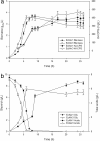Homologous overexpression of RfaH in E. coli K4 improves the production of chondroitin-like capsular polysaccharide
- PMID: 23659469
- PMCID: PMC3673904
- DOI: 10.1186/1475-2859-12-46
Homologous overexpression of RfaH in E. coli K4 improves the production of chondroitin-like capsular polysaccharide
Abstract
Background: Glycosaminoglycans, such as hyaluronic acid, heparin, and chondroitin sulfate, are among the top ranked products in industrial biotechnology for biomedical applications, with a growing world market of billion dollars per year. Recently a remarkable progress has been made in the development of tailor-made strains as sources for the manufacturing of such products. The genetic modification of E. coli K4, a natural producer of chondroitin sulfate precursor, is challenging considering the lack of detailed information on its genome, as well as its mobilome. Chondroitin sulfate is currently used as nutraceutical for the treatment of osteoarthritis, and several new therapeutic applications, spanning from the development of skin substitutes to live attenuated vaccines, are under evaluation.
Results: E. coli K4 was used as host for the overexpression of RfaH, a positive regulator that controls expression of the polysaccharide biosynthesis genes and other genes necessary for the virulence of E. coli K4. Various engineering strategies were compared to investigate different types of expression systems (plasmid vs integrative cassettes) and integration sites (genome vs endogenous mobile element). All strains analysed in shake flasks on different media showed a capsular polysaccharide production improved by 40 to 140%, compared to the wild type, with respect to the final product titer. A DO-stat fed-batch process on the 2L scale was also developed for the best performing integrative strain, EcK4r3, yielding 5.3 g ∙ L(-1) of K4 polysaccharide. The effect of rfaH overexpression in EcK4r3 affected the production of lipopolysaccharide and the expression of genes involved in the polysaccharide biosynthesis pathway (kfoC and kfoA), as expected. An alteration of cellular metabolism was revealed by changes of intracellular pools of UDP-sugars which are used as precursors for polysaccharide biosynthesis.
Conclusions: The present study describes the identification of a gene target and the application of a successful metabolic engineering strategy to the unconventional host E. coli K4 demonstrating the feasibility of using the recombinant strain as stable cell factory for further process implementations.
Figures






Similar articles
-
Engineering a branch of the UDP-precursor biosynthesis pathway enhances the production of capsular polysaccharide in Escherichia coli O5:K4:H4.Biotechnol J. 2015 Aug;10(8):1307-15. doi: 10.1002/biot.201400602. Epub 2015 Jul 24. Biotechnol J. 2015. PMID: 26153362
-
KfoA, the UDP-glucose-4-epimerase of Escherichia coli strain O5:K4:H4, shows preference for acetylated substrates.Appl Microbiol Biotechnol. 2018 Jan;102(2):751-761. doi: 10.1007/s00253-017-8639-0. Epub 2017 Nov 20. Appl Microbiol Biotechnol. 2018. PMID: 29159585
-
Physiological characterization and quantitative proteomic analyses of metabolically engineered E. coli K4 strains with improved pathways for capsular polysaccharide biosynthesis.Biotechnol Bioeng. 2018 Jul;115(7):1801-1814. doi: 10.1002/bit.26597. Epub 2018 Apr 12. Biotechnol Bioeng. 2018. PMID: 29578572
-
RfaH and the ops element, components of a novel system controlling bacterial transcription elongation.Mol Microbiol. 1997 Dec;26(5):845-51. doi: 10.1046/j.1365-2958.1997.6432014.x. Mol Microbiol. 1997. PMID: 9426123 Review.
-
[Microbial production of chondroitin sulfate: a review].Sheng Wu Gong Cheng Xue Bao. 2012 Nov;28(11):1281-93. Sheng Wu Gong Cheng Xue Bao. 2012. PMID: 23457781 Review. Chinese.
Cited by
-
Engineering S. equi subsp. zooepidemicus towards concurrent production of hyaluronic acid and chondroitin biopolymers of biomedical interest.AMB Express. 2017 Dec;7(1):61. doi: 10.1186/s13568-017-0364-7. Epub 2017 Mar 14. AMB Express. 2017. PMID: 28293868 Free PMC article.
-
Production and purification of higher molecular weight chondroitin by metabolically engineered Escherichia coli K4 strains.Sci Rep. 2020 Aug 6;10(1):13200. doi: 10.1038/s41598-020-70027-9. Sci Rep. 2020. PMID: 32764548 Free PMC article.
-
Differential Secretome Profiling of Human Osteoarthritic Synoviocytes Treated with Biotechnological Unsulfated and Marine Sulfated Chondroitins.Int J Mol Sci. 2020 May 26;21(11):3746. doi: 10.3390/ijms21113746. Int J Mol Sci. 2020. PMID: 32466468 Free PMC article.
-
Masquerading microbial pathogens: capsular polysaccharides mimic host-tissue molecules.FEMS Microbiol Rev. 2014 Jul;38(4):660-97. doi: 10.1111/1574-6976.12056. Epub 2014 Jan 27. FEMS Microbiol Rev. 2014. PMID: 24372337 Free PMC article. Review.
-
New insight into chondroitin and heparosan-like capsular polysaccharide synthesis by profiling of the nucleotide sugar precursors.Biosci Rep. 2017 Feb 20;37(1):BSR20160548. doi: 10.1042/BSR20160548. Print 2017 Feb 28. Biosci Rep. 2017. PMID: 28104792 Free PMC article.
References
-
- Achur RN, Kakizaki I, Goel S, Kojima K, Madhunapantula SV, Goyal A, Ohta M, Kumar S, Takagaki K, Gowda DC. Structural interactions in chondroitin 4-sulfate mediated adherence of Plasmodium falciparum infected erythrocytes in human placenta during pregnancy-associated Malaria. Biochemistry. 2008;47(47):12635–12643. doi: 10.1021/bi801643m. - DOI - PMC - PubMed
MeSH terms
Substances
LinkOut - more resources
Full Text Sources
Other Literature Sources
Molecular Biology Databases

